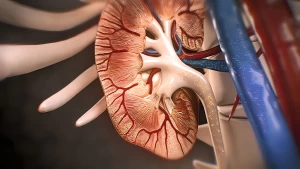Adrenal Vein Sampling
What is Adrenal Vein Sampling?
Hypertension, or high blood pressure, is a dangerous condition that can lead to serious medical problems such as stroke, heart failure and kidney disease. In most cases, the cause of a patient’s hypertension is never found. However, there are several disease processes that cause hypertension that are treatable, such as Conn’s Syndrome, a condition in which the adrenal glands release abnormally high levels of the hormone aldosterone into the bloodstream. This hormone causes high blood pressure as well as electrolyte problems such as a low potassium level.
How is Conn's Syndrome Diagnosed?
Conn’s Syndrome can be diagnosed with a blood screening test known as an aldosterone-renin ratio. This will tell your physician if you have too much aldosterone in your blood. If hyperaldosteronism is confirmed, the next step is to identify if one or both adrenal glands is secreting the hormone. This is because if the aldosterone is only released by one adrenal gland, surgically removing the offending adrenal gland is curative of the hypertension. A CT scan can suggest the side of the abnormal gland by noting a nodule within one of the adrenal glands. However, nodules are common and in many cases do not secrete abnormal levels of hormones. Directly taking samples of the blood leaving each adrenal gland allows physicians to be certain if one or both of the adrenal glands are secreting abnormal amounts of hormones. This procedure is called adrenal vein sampling.
How is Adrenal Vein Sampling Performed?
Adrenal vein sampling is a procedure performed by vascular and interventional physicians to directly measure the hormones released by the adrenal glands. If one adrenal gland is releasing significantly more hormone than usual, removing this gland surgically may cure the hypertension. To do this, a vascular and interventional physician will access a vein in either the patient’s neck or groin, and thread a catheter (small tube) to the veins draining the adrenal glands. This will be done under x-ray guidance.
After injecting a small amount of contrast (x-ray dye) to confirm positioning, samples of blood will be taken from both the right and left adrenal veins; these samples will be sent to the lab for analysis. Once samples are taken, the catheter will be removed and gentle pressure will be applied to stop any bleeding. The patient is able to go home shortly after the procedure. Results of the blood tests are available a few days following the procedure.
What are the Risks of Adrenal Vein Sampling?
Risks of adrenal vein sampling are relatively mild and infrequent, but include bleeding, infection, damage to the veins and allergic reaction to the contrast dye.














































































